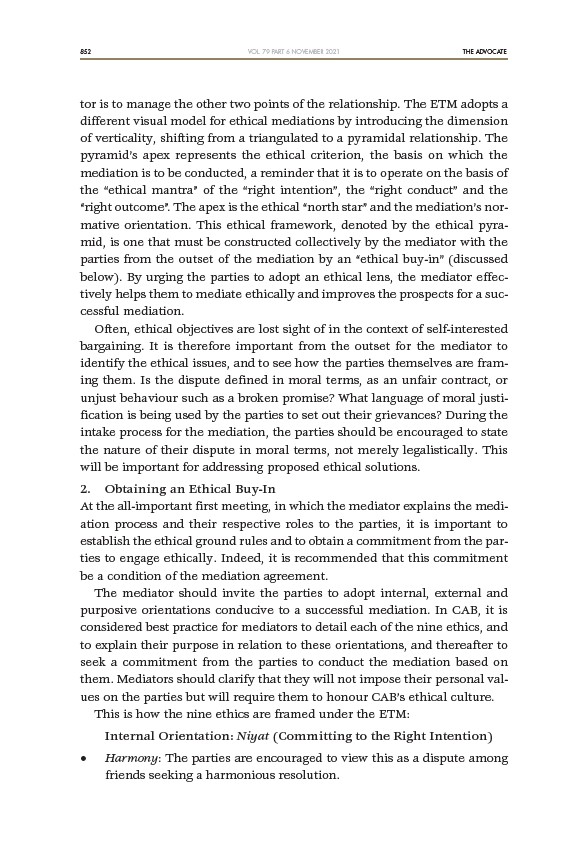
852 THE ADVOCATE
VOL. 79 PART 6 NOVEMBER 2021
tor is to manage the other two points of the relationship. The ETM adopts a
different visual model for ethical mediations by introducing the dimension
of verticality, shifting from a triangulated to a pyramidal relationship. The
pyramid’s apex represents the ethical criterion, the basis on which the
mediation is to be conducted, a reminder that it is to operate on the basis of
the “ethical mantra” of the “right intention”, the “right conduct” and the
“right outcome”. The apex is the ethical “north star” and the mediation’s normative
orientation. This ethical framework, denoted by the ethical pyramid,
is one that must be constructed collectively by the mediator with the
parties from the outset of the mediation by an “ethical buy-in” (discussed
below). By urging the parties to adopt an ethical lens, the mediator effectively
helps them to mediate ethically and improves the prospects for a successful
mediation.
Often, ethical objectives are lost sight of in the context of self-interested
bargaining. It is therefore important from the outset for the mediator to
identify the ethical issues, and to see how the parties themselves are framing
them. Is the dispute defined in moral terms, as an unfair contract, or
unjust behaviour such as a broken promise? What language of moral justification
is being used by the parties to set out their grievances? During the
intake process for the mediation, the parties should be encouraged to state
the nature of their dispute in moral terms, not merely legalistically. This
will be important for addressing proposed ethical solutions.
2. Obtaining an Ethical Buy-In
At the all-important first meeting, in which the mediator explains the mediation
process and their respective roles to the parties, it is important to
establish the ethical ground rules and to obtain a commitment from the parties
to engage ethically. Indeed, it is recommended that this commitment
be a condition of the mediation agreement.
The mediator should invite the parties to adopt internal, external and
purposive orientations conducive to a successful mediation. In CAB, it is
considered best practice for mediators to detail each of the nine ethics, and
to explain their purpose in relation to these orientations, and thereafter to
seek a commitment from the parties to conduct the mediation based on
them. Mediators should clarify that they will not impose their personal values
on the parties but will require them to honour CAB’s ethical culture.
This is how the nine ethics are framed under the ETM:
Internal Orientation: Niyat (Committing to the Right Intention)
• Harmony: The parties are encouraged to view this as a dispute among
friends seeking a harmonious resolution.